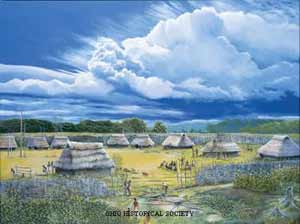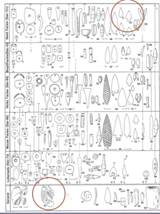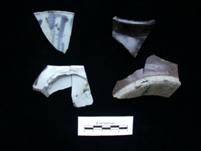Weber Avenue Site Significance to CA Archaeology and History
We have learned a little about the Weber Avenue site's discovery, its artifacts, and Native American burials, but how does this archaeological site fit into the big picture of California history? What can it tell us?

Thousands of Years Ago...
The diverse collection of prehistoric artifacts from the site help to address some important questions such as: What is the occupation history of the site? Who lived here, and when?
The prehistoric artifacts suggest that the Weber Avenue site belongs to what archaeologists call the Middle to Late Period (2,500 years ago - 1,100 years ago). This was a time when people hunted and fished for a wide variety of mammals, birds, and river creatures such as salmon and shellfish. They lived off the land and its abundant resources; acorns were a part of most family meals. Tool and crafts were also becoming more and more plentiful and complex during this time. By the Late Period, people buried their loved ones with special grave offerings such as baskets, beads and pipes.
With a little more research, archaeologists believe that the Weber Avenue site can help shed light on questions about early trade networks in California, how tools were made, and why styles changed, as well as details about early Native American social life. These are all very important questions and a lot remains for us to figure out. The Weber Avenue site is a valuable piece of a big prehistoric puzzle.
In Historic Times
The site's historic period is also special. The artifacts found, including household trash, bottles, kitchenware, construction materials, and personal items, like a piece of an old necklace and a clay pipe, can tell us about the lives of Stockton's first residents.
Archaeologists can learn about which ethnic groups might have been working in warehouses. They can see what commercial products people used and liked the best. They can also gain an understanding about class difference back in the early days of the city, for example, who was rich and who was poor. Historic archaeology reveals fascinating details about the past that the history books sometimes do not mention.
 It looks complicated, but archaeologists use charts, like the one pictured at right, to help date artifacts and sites. Each section represents a time period and each time period has its own special style. For example, if a human burial is found or a collection of stone tools, the chart can help place each in its correct time frame.
It looks complicated, but archaeologists use charts, like the one pictured at right, to help date artifacts and sites. Each section represents a time period and each time period has its own special style. For example, if a human burial is found or a collection of stone tools, the chart can help place each in its correct time frame.
The Weber Avenue site contained a small amount of Chinese pottery, some rice bowl pieces, and a couple of Chinese storage jars. While these are typical artifacts to find in the area, they do suggest that a Chinese family or some warehouse workers may have been in the area.
External Links
There are currently no external links.
This City of Stockton web page last reviewed on --- 5/12/2015
